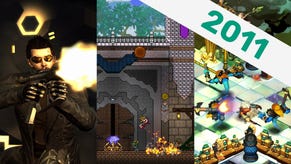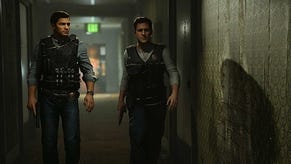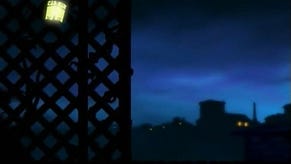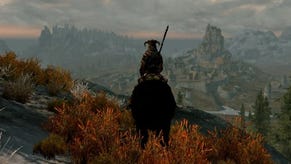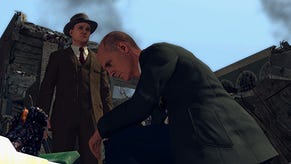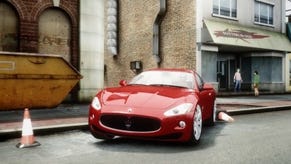Hands On With L.A. Noire On PC
Why Do They Call It Los Angeles?
We sent Agent Smee to study the case of the L.A. Noire port to PC. This is the detailed report he sent back. Having studied its contents, we have no reason to suspect foul play.
The notebook I carry around everywhere is an unreadable mess. Written in handwriting so poor I can barely sometimes decipher my own words, it’s a collection of incomprehensible interview notes, indecipherable idle thoughts, scrawled doodles, contact details inevitably copied down incorrectly and shopping lists written over one another in different coloured ink before being scribbled out. It’s a nightmare, is what I’m saying, so playing LA Noire in the presence of the hard-nosed Detective Cole Phelps turns out to be some kind of lurid personal fantasy. His notebook, you see, is beautiful. Meticulous, organised, copperplate writing, lifelike portraits and intricate still life pencil compositions, the perfect tool of organised life. It’s not exactly often I find myself jealous of fictional videogame characters, but boy howdy do I want to be able to organise a notebook as well as Phelps.
Sitting down with Rockstar’s rep in their cavernous demo room I played one of the new DLC missions released recently for the consoles: Nicholson Electroplating. All of the DLC content
will be standard issue for the PC release by the way, missions and new outfits included. The man from Rockstar was keen to stress the build wasn’t final, though it was clear gold status wasn’t far off. Apart from a couple of brief loading screens he was at pains to say wouldn’t be in the final release, it ran as smooth as butter on the beefy PC provided and looked great with increased resolutions and higher quality textures than its console origins.
Like Rockstar’s previous effort with GTA IV’s PC conversion, the options screen included all the proper bells and whistles that should be in a proper PC game. Keyboard and mouse played just fine, though a gamepad could easily be switched in without a fuss. On top of the standard configuration, LA Noire supports 3D gaming for those of you who own multiple wallets to carry all your money. Playing in 3D was startlingly fancy and added a strong sense of depth, especially while manipulating evidence during the crime scene investigations. Unfortunately the 3D suffers from the usual effect of darkening the screen, which was a real problem in later shadowy locations. It was also quick about alt-tabbing, so that’s nice too.

The DLC case begins with a bang – an almighty explosion across town blows smoke high in the sky. No objective marker on your mini map, your only recourse is to drive towards the plume, keeping an eye on the smoke-filled horizon as you weave through panicking city traffic. It was enough to make it immediately feel like a different experience than the GTA standard Drive Here, Watch Cutscene, Shoot Men. Then I ended my drive at the scene of the explosion, watched a cutscene and then shot men.
Not off to a particularly revelatory start then, but after the brief battle with opportunistic looters the mood changed to something else entirely. Holstering his piece, Phelps steps up to the ruined remains of a chemical factory and walks into a completely different game. It’s a point and click adventure, frankly. It doesn’t play like a point and click, it doesn’t broadly resemble it: it is, plain and simple, a point and click adventure game, complete with searching the environment for inventory items, combining them and using them to figure out puzzles. Just, you know, in the midst of dozens of dead bodies and the ruins of an explosion with an as yet unknown cause.
I began to quietly wander around the ruined scene, looking for clues in amongst the rubble and the bodies as the mood-perfect 40s soundtrack drifted through the room. There’s more silent gravity felt in this one scene than most action games can muster in their lifetime. Indeed, Rockstar are adamant that LA Noire isn’t an action game at all, calling it a Detective Thriller and describing it as 70% investigation, 30% action, with many cases being entirely conversation/investigation based. Call me old fashioned, but that’s a pretty exciting prospect, especially when I saw how the rest of the case played out.

Investigating a scene, something I did in three different locations during the case, is handled by walking Phelps around and clicking when he’s standing over something of note, allowing him to pick it up for detailed inspection in a zoomed-in first person view. There’s an immediate tactile delight in using the mouse to guide Phelps’ hands to turn over crime scene evidence, looking for any telltale clues. Mouse control during these parts was overly sensitive however, resulting in cack-handed interaction, though Rockstar mentioned that was on the bug list. It was easy to see how naturalistic the movements would be once that’s been sorted.
The mechanics handling these investigation sections manage to tick a number of boxes at once, from the naturalistic positioning of evidence (finding a shirt in a locker and a business’s dry cleaning tag attached to it, for instance) to the dynamic music as more interesting clues were found. A brief piano key tickles your ears when you’re in a searchable area, and Phelps’ head turns to look around him at interesting objects as he walks, Grim Fandango style. There was a huge amount of material scattered around, some obviously important to the case but most incidental.
Still, all of it came together to form part of a narrative that fed into the imagination in the way the set dressing of the recent Fallouts did – who these people were, hints about what their lives were like. It was a relief to uncover a suitcase filled with top secret spy gear. Quickly the mood shifts again – industrial espionage! A rummage in the case points towards a spy on the loose with possible Japanese origins. Deciphering a mystery address using equipment in the spy’s toolkit is a breezy little puzzle, and Phelps automatically notes the location to his notebook, allowing you to drive over there to further the investigation.

Before that little trip however comes the first interrogation of the case. The owner of the factory has just turned up at the explosion site, and Phelps corners him for questioning. The way it works, if you haven’t played LA Noire on the consoles before, is thus: Choosing from a set of questions written in Phelps’ notebook based on evidence you’ve uncovered, you can pump the target for information. After his response, decide then if he’s telling the truth or, more intriguingly, a devious little liar liar pants-on-fire with something to hide. If you think or know the chap might be lying, you’ll need proof in the form of the evidence you’ve gathered so far in the case, which typically nails the sucker. If you don’t have any proof but still suspect them you can opt for Doubt, which ostensibly makes Phelps press the target to give something up. It’s been a common observation since the PS3 release that Doubt turns Phelps into an insane screaming psychopath, though in this mission at least all the Doubt options I went for were reasonable accusations, even if Phelps’ delivery did send my non-confrontational British heart of mine into a panicked quiver at all the angry noises.
It’s a neat, simple system and the brief uses of it during the mission were satisfying to use, especially when I could make a couple of deductive leaps along the way, the suspicious wag that I am. Phelps does however come across as a tad schizophrenic, since there’s no way of knowing what line of questioning Truth/Lie/Doubt will elicit from the lad, and a couple of times he went down a route in response to the subject’s answer I hadn’t even considered when thinking about the evidence I had gathered. It could be seen as taking control away from the player, though personally I was grateful for a small steadying hand during the preview – how my feelings might change over the course of a whole game of this sort of behaviour is something to be left for the full release.

Following that were more thoughtful interrogations and crime scene investigating all over town as Phelps and I gradually uncovered a deceitful money-making plot. Just when I thought I was about ready to nail some suspects in the course of the investigation, the case surprised me by picking up rather a lot of speed, ending with an escape from a burning building, a speedy car chase and a remarkably thunderous finale featuring a two-man assault on a military compound to take out a machine gun nest and a private army, of all things. It was mildly over the top but thrilling all the same – just like an episode of a police drama that begins and ends with a little slice of action, the middle filled with dialogue and investigation. Just put through the action-exaggeration machine.
Of course it’s with the much talked about facial animation technology where LA Noire’s visuals really shine, and shine it does: it’s nothing less than astounding, every time it’s on screen. Unfortunately it has a peculiar side effect of making everything else look worse, even though the environments and city are clearly expensively constructed and meticulously detailed. The problem is the faces look so good and so lifelike compared to the rest of the world, it’s almost as if the game is shot through one of those seaside photo booths that let you stick your face through a hole in a painted cartoon scene. That unfortunate effect however is diminished and frequently defeated during the conversations and interrogations, it’s just that seeing Phelp’s little human face poking out above his little video game body as he’s walking around can be a little creepy every now and then when you catch it at a particular angle.

The actual acting shown in the mission was strong, though sometimes verged a little on the hammy side, especially when an actor’s interpretation of “tell a lie” is to look less convincing than a guilty child standing next to a broken vase. Rockstar sees this as a benefit however: “Now the acting can be a little hammy, but we wanted it to be that way sometimes, to empower the player. To show that this guy really is a slimy sleaze scumbag who needs to be taken down – that’s really satisfying.” True enough, though I’m looking forward to cracking harder nuts all the same. On the other hand, the two lead actors were solid performances.
Detective Cole Phelps played by Ken Cosgrove, Accounts From Mad Men is professional and guarded during the case, and at all times was partnered with the adorably surly Herschel Biggs, played by Oh You Know, That Police Officer The Joker Taunts In Batman Dark Knight And Also Kidnaps Angel’s Baby In Season 3 And Turns Him Into Pete Campbell From Mad Men And Wasn’t It Odd When He Had Sex With Cordelia?. The cast is filled with similar “Oh, him!” moments, making the experience a rather jolly novelty. It’s a feeling uncommon to gaming, as previously only distinctive celebrity voices sometimes stand out, and all builds on the mood of a police drama, with the guest actor of the week making a stand out appearance.
So it looks like it’s LA Noire on PC. Is that surprising to hear? As far as I can tell from a couple of hours playing, it has all the strengths and weaknesses it had when it came out on console, wrapped up in a really nice looking package. There’s no doubt the PC version is looking fab with its sharp textures and anti aliasing. It’s pretty much everything you want in a good PC conversion, though it doesn’t actually feel like a conversion – with its point and clicking, note keeping and mostly sombre pace, it feels like it’s the best extension yet of classic, very PC adventure games.
It’s coming home on November 8th in the US and November 11th in Europe.

